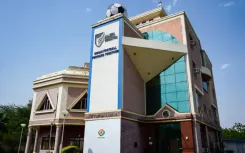Has Public Capex to Budget Estimate Ratio Increased by 7% in April-May?

Synopsis
Key Takeaways
- Capital expenditure increased to 20% of budget estimate in April-May FY26.
- Union Budget 2025-26 allocated Rs 11.21 lakh crore for capex.
- Manufacturing PMI reached a fourteen-month high at 58.4.
- Tax revenue from GST collections rose by 11.8%.
- CPI inflation eased to 2.1% in June.
New Delhi, July 23 (NationPress) The Centre’s capital expenditure reached 20 percent of the budget estimate during April-May FY26, marking a significant increase from 13 percent in the same timeframe last year, as reported on Wednesday.
The Union Budget 2025-26 allocated a hefty Rs 11.21 lakh crore for capital expenditure, which constitutes 3.1 percent of the GDP.
This rise in government capex is contributing positively to the manufacturing sector, with India’s Manufacturing Purchasing Managers’ Index (PMI) climbing to 58.4 in June, the highest in fourteen months, according to a report from credit rating agency CareEdge Ratings.
Meanwhile, the Services PMI reached 60.4, its peak level in the past ten months. However, industrial production witnessed a modest growth of only 1.9 percent during April-May FY26, down from 5.7 percent in the same period last year, largely due to contractions in the electricity and mining sectors that impacted overall IIP growth.
On a positive note, tax revenue has seen growth, with GST collections and E-way bills generation increasing by 11.8 percent and 20.5 percent in Q1 FY26.
In FY26, GDP growth is estimated at 6.4 percent and the current account deficit at 0.9 percent, according to the agency’s forecast. Meanwhile, CPI inflation dropped to 2.1 percent in June, significantly below the Reserve Bank of India’s target of 4 percent, attributed to lower food inflation and a favorable base.
The report states, "We do not foresee further RBI rate cuts unless downside risks to growth materialize."
While businesses may not anticipate reduced loan costs due to steady rates, ample liquidity is available. The report also indicates that the Weighted Average Call Rate (WACR) stood 24 bps below the policy rate in July but might increase with Variable Rate Reverse Repo (VRRR) auctions.
Since early May, the rupee has depreciated by approximately 2.3 percent against the dollar, yet it remains 1.6 percent stronger than its lows in February. India’s forex reserves continue to serve as a critical buffer, totaling $697 billion, providing a sufficient import cover, the report mentioned.









